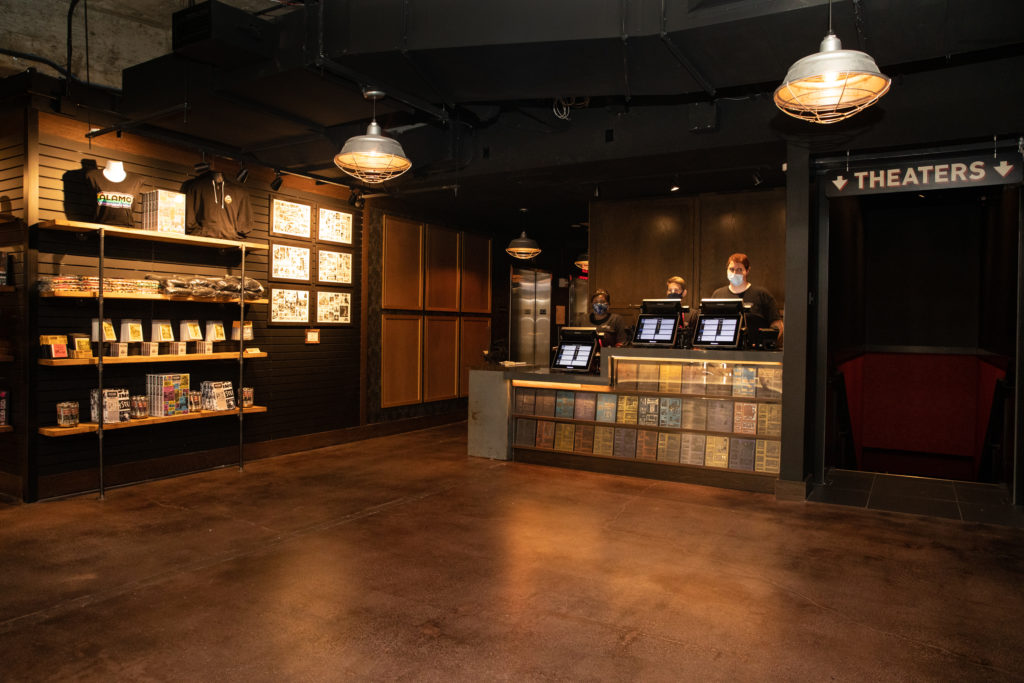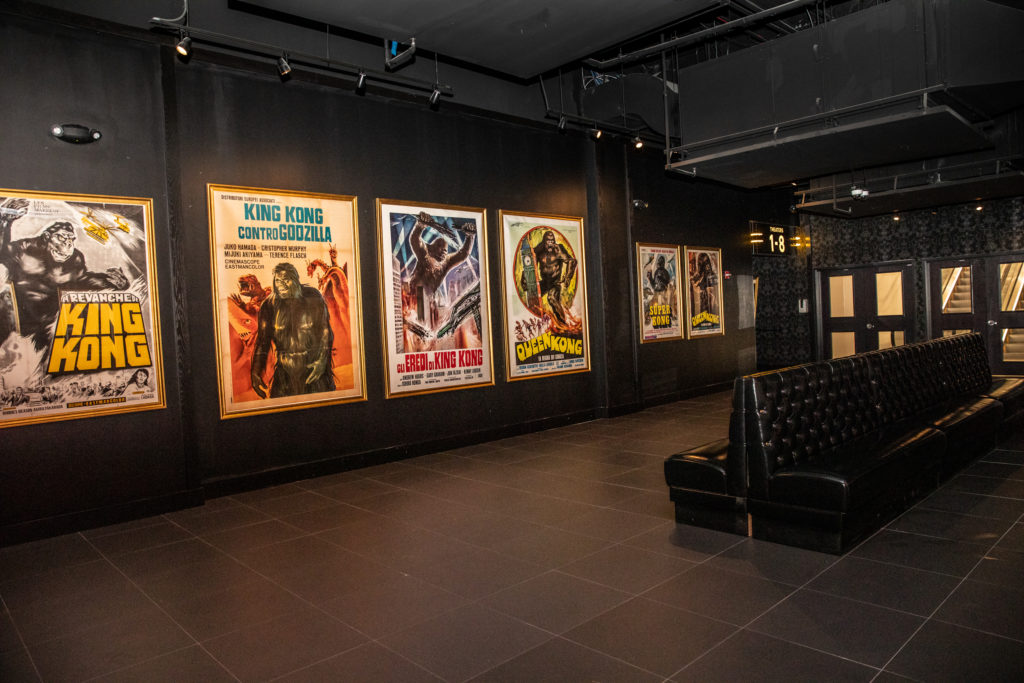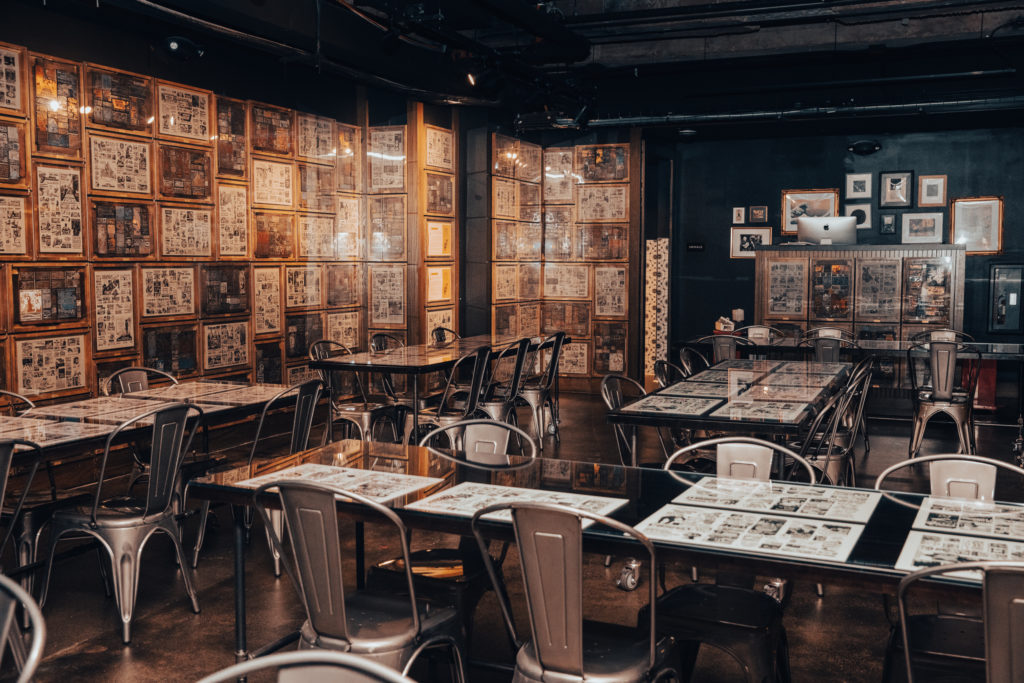Boxoffice Pro’s history with Alamo Drafthouse dates back to its inception. Founder Tim League reminisced about using the magazine as a reference in guiding him through the opening of his first cinema. The publication has kept close ties covering the circuit throughout its growth, particularly as a catalyst to the nationwide expansion of the dine-in cinema concept. After more than six years in development, Alamo Drafthouse finally opened its first Manhattan location in New York City this October, culminating an effort that League calls among the most challenging of his career as an exhibitor.
Located in the heart of the financial district, a short subway ride away from its existing Brooklyn location that opened in 2016, Alamo Drafthouse’s Lower Manhattan cinema expands the circuit’s reach in one of the world’s top exhibition markets. The site features 14-screens, matching Alamo’s Springfield, Missouri location as its highest in the circuit, all boasting recliner seating with call-button service, 7.1 surround sound, and 4k laser projection from Cinionic. The high screen count is strategic, meant to expand Alamo’s programming options in the New York market (the Brooklyn location has 7 screens), intentionally designed with an intimate feel: its highest-capacity auditorium seats under 60 people.
That flexibility in programming is crucial for a circuit whose brand is known for being at the intersection of mainstream, independent, and repertory cinema. Alamo’s combined 21 screens in New York City allows the circuit to stake a flag as a leading player in arguably the most important market for the type of films it champions. Complementing that experience is a themed-bar, The Press Room, which features a unique and exclusive collection of vintage movie advertising plates on display—also available for purchase to patrons who want to come back home with a souvenir of their visit. The bar has a fully customizable drink menu in a spacious area that can accommodate live events and private bookings.
Alamo Drafthouse’s Lower Manhattan location represents an important evolution in the circuit’s return from Chapter 11 bankruptcy, a result of the financial impact of the pandemic on the cinema industry. Boxoffice Pro spoke with Alamo Drafthouse Founder and Executive Chairman Tim League shortly after the Lower Manhattan location’s official launch to catch up on where the iconic dine-in chain is today—and where it’s headed in the future.

Photo Credit: Michael Mansfield
Let’s start with where you are now at Alamo Drafthouse. The circuit filed for Chapter 11 bankruptcy during the pandemic. You’re now opening a new theater in New York City.
Bankruptcy is such a loaded word. It was part of a longer-term restructuring process. So we entered bankruptcy by design, and knew that there was a clear path out of it. So having a fire sale and putting the projectors out on the curb was never part of the process. And you know, the good side is we’re refinanced and stable and have rebuilt the team, and we’re ready to open more. So we’re actually aggressively out there looking for new locations.
During the pandemic, one of the things that really made me smile while we were in the thick of it was when Alamo Drafthouse released some of its recipes to make at home. It was something that helped Alamo Drafthouse moviegoers keep in touch with the Alamo experience. What was your strategy to keep in touch and engage with your audience while all your theaters were closed?
It was such a strange time. There’s lots of things that we tried to do when we weren’t able to show movies. We built Alamo on Demand, an on-demand platform where we started doing some of our signature shows. We would do group watch parties for AGFA [American Genre Film Archive] screenings, our programming series Weird Wednesday, and we did a virtual Fantastic Fest. Not only did it keep the community together as best as we could, but it also expanded it. Strangely, we’d have people tuning in from all over the globe that had heard about some of these programming series and had never had the opportunity to come to Austin or New York and experience them.
What is the current footprint of the Alamo Drafthouse circuit?
There’s 36 locations and we have about five that are under construction. I forget the exact screen count, it’s around 270 or so screens. So it’s a little bit shrunk. We closed some that just really weren’t making money and probably weren’t going to make it out of the tough times of 2020. Right now, we’re marching forward and will be bigger than we were, probably within a year.

Photo Credit: Michael Mansfield
A big part of that is this milestone opening here in New York City. Over six years in development, I remember when you were looking at a location in the Upper West Side, but you’ve finally made it to Manhattan. You’re now open in the Financial District of Lower Manhattan. Can you tell us about that process? Is this the hardest cinema you’ve opened since you became an exhibitor?
It’s a tie between this one and San Francisco. San Francisco was a full inside-and-out historic renovation of a 1914 theater, and that has its own challenges. So we had to seismically reinforce the lobby. We had to tear down historic plaster, scan it, and then rebuild it. It was a ridiculous process. This is a close second.
One of the things that stands out from this New York City location is its retail component, with a gift shop welcoming patrons at the lobby where they can buy merchandise. It’s not something we see often in cinemas. What was the strategy and vision behind that?
We started as a mom and pop theater, a single screen, with my wife. It was literally Mom and Pop: I was Pop, she was Mom. And then, as we started to expand, we developed this idea of having other elements to the brand that all spoke to the same audience. You know, “For movie lovers, by movie lovers.” That was the impetus for starting Mondo 15 years ago. It was an onsite retail store. We’ve expanded over the years into a lot of different categories, like posters and vinyl soundtracks. During the pandemic, I ran the board games and puzzles division for a year, and I’m really quite sad about leaving that because I love board games, I love puzzles. But it’s going to continue on. During the pandemic, Mondo was really successful. People were at home and wanting to do things at home, wanting to listen to more records and play more two-person games. I want people to come to an Alamo Drafthouse and have a feeling like, “Oh my gosh, this doesn’t feel like a regular movie theater.” Entering and having a really cool, interesting bar, like the Press Room we have here in our Manhattan location. Having a retail component is part of that. I’m a movie love and all these things might speak to me as something I might want to take back home with me to continue that experience.
You’re also experimenting with ticket bundles, where the ticket also includes a merchandising aspect of a film. That makes moviegoing more of an experience, leaving the house and coming back with a memento.
I think the best version of that is right here at the Manhattan theater, by incorporating the Press Room, which is a print shop with vintage movie ads at the heart of it. Over the next few months, we’re going to really explore that in a big way. Like, if you are going to watch Some Came Running with Shirley MacLaine, you’ll be able to print a little poster or a note card from the original 1960s plate it was made from. It’s an amazing experience. We’re going to allow the guests to actually run the press themselves and explain how it works and what the history behind it is. It’s part of this idea that, yeah, you can just see a movie, but how can we make this incredible memory for you that’s really special and you’ll remember forever?
You have seven screens already open in Brooklyn. You’re adding 14 now to New York City with this Manhattan location. What does that permit you to do here in New York?
It means we get to play everything we want to play. Some of the toughest decisions and conversations we have are like, “I’m sorry, but we have to open Spider-Man or we have to open up The Avengers.” And that means we can’t play other movies like documentaries, foreign language films, and the smaller Indies that don’t get the screen placement during times where there’s a lot of blockbusters. We are a weird hybrid that plays repertory, blockbusters, and indie. With 14 screens, and they all have a relatively low seat count, that means we can open up everything we want. And we want to show everything. We want to support Sony Pictures Classics, Kino Lorber, and Oscilloscope. And we haven’t been able to do as good a job as we want to, especially in New York, and the city is a hugely important market to open a film, so I’m excited to be able to support more movies we love.
Alamo Drafthouse has been able to crack the code on repertory during off-peak periods, going into your archives through AGFA [American Genre Film Archive] on Tuesday or Wednesday nights. How has that part of your business grown over the last five years, when the rest of exhibition is wondering, “How can I make off-peak work?”
I think it speaks to building an audience. We have some signature shows that run weekly in our big cities: Terror Tuesday, Weird Wednesday. And there’s a vibe to it. The people that are interested in watching a pretty strange repertory movie from the ’60s, ’70s, ’80s, and having a host talk to you about why this is special and why they love it. Watch vintage trailers. It’s like a little micro-community. Committing to that: we love this, we know it’s awesome, and I know in this city of 8 million people there’s other weirdos like me. So let’s gather and let’s make Wednesday our day.
Earlier this summer, there was a particularly embarrassing bad hot take on the death of cinema in the New York Times. We’ve seen these reports pop up for as long as there have been movie theaters—they’ve always been wrong—but you actually spoke up and replied to this one. Why is it important for figures in this industry to stand up and correct the record when we encounter some of this speculation from people who are so uninformed about this business?
Anybody that loves movies inherently gets it. The idea that, “Oh, cinemas are dead, cinema is dying,” they’ve been predicting that since the advent of black and white television in the ’50s, to the VCR, to the DVD player, to streaming, to Netflix, to everything. I’ll give you a concrete example of what happened earlier this month, with the opening of Dune. You can watch Dune on HBO Max. I cry for those human beings that are going to make that decision and watch it on their goddamn iPad. That movie is cinema, it’s grand…just even talking about it, I’ve got goosebumps because it’s so immersive, such a visceral experience. It is cinema. But it’s not cinema on your iPad or on your phone, or when you’re multitasking and checking your email on the train. Yeah, I guess you can get the basic plot points, and you can talk about it at work and say you saw it. But did you really see it? That movie is intended for the cinema. At its best, it’s a phenomenal experience. I love that there’s a bit of pressure on the industry to say, “No, we know at our best that this is an unstoppable force, and people want to get out of the house and experience it. So let’s be at our top game, everybody.” We all should be on our top game, and we’re going to be just fine.

Photo Credit: Michael Mansfield
The post Tim League on Alamo Drafthouse’s New NYC Location appeared first on Boxoffice.
from Boxoffice





0 comments:
Post a Comment